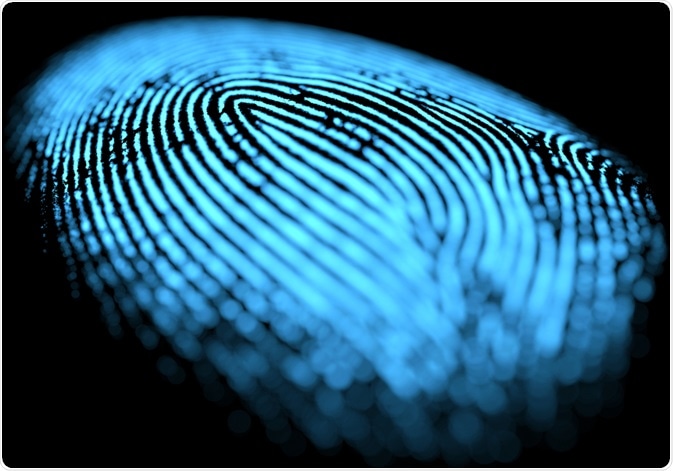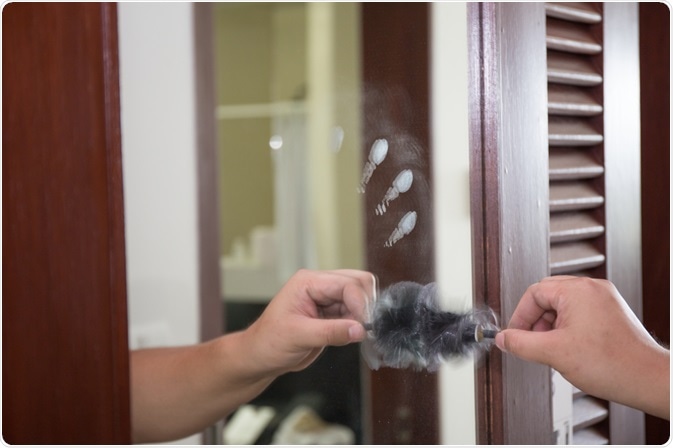Analyzing fingerprints left at the scene of a crime is one of the most critical parts of forensic analysis. Fingerprint analysis typically helps to connect the crime to a person who may have been present at the scene but can also be used to track a person’s previous records; arrests, parole, and other details.
 Image Credit: ktsdesign/Shutterstock.com
Image Credit: ktsdesign/Shutterstock.com
Principles behind fingerprint analysis
The furrows and ridges present on your fingers, toes, and palms create a unique pattern. Fingerprint analysis relies on this unique pattern, and forensic scientists will group patterns into the following distinct groups:
Loops: This pattern recurves on itself and forms a loop shape. This can be further divided into a radial loop that points towards the thumb or an ulnar loop that points towards the ulna bone. These loop patterns form the majority of the fingerprint (60%).
Whorls: These are circular patterns similar to whirlpools. They can be plain or concentric whorls, a central pocket loop that is a loop with a whorl at one end, a double loop (two loops in an S-shaped pattern), or an accidental loop that carries an irregular shape. These patterns constitute about 35% of a person’s fingerprint.
Arches: These are wave-like and consist of plain arches and bent arches that rise to a sharper point compared to plain arches. These patterns form 5% of the fingerprint.

Image Credit: Everilda/Shutterstock.com
Persistent patterns
These patterns remain consistent with age. Studies conducted over decades show that these patterns remain unchanged throughout a person’s life. Even in cases where new skin develops, it forms in the existing ridge and furrow patterns already established in the finger. In cases where the skin is damaged, the new skin also follows previous patterns.
The above-mentioned patterns are used to include or exclude a fingerprint from the analysis. The fingerprint analyst uses specific points on the ridge to identify and compare similar points on an unknown fingerprint. If a significant number of points correlate between the two fingerprints then they are said to be of the same person.
How are fingerprints collected?
Patent prints
Patent prints are collected using the standard manner of photography. The prints are photographed in high resolution using a forensic measurement scale. The quality of images can also be further improved using low light or alternate light sources, chemicals, dyes, etc.
Latent prints
Latent prints are collected by dusting a smooth surface with the fingerprint powder, such as black granular, aluminum flake, and black magnetic). On dusting the powder, if prints emerge, they are then photographed using a camera, lifted from the surface using an adhesive tape. The tape can then be kept on a latent lift card to preserve it.
However, sometimes, using fingerprint powder can also contaminate the fingerprint, preventing further analysis. An alternative to latent prints is the use of an alternate light source or super glue before applying the fingerprint powder.

Image Credit: Prath/Shutterstock.com
Alternate light sources
Investigators are beginning to use an alternate light source for examining surfaces, such as doors, doorknobs, windows, etc. Usually, a laser or LED light is used that emits light at a particular wavelength. These devices may also have different filters that provide different spectra for the purposes of photographing or further processing.
Cyanoacrylate
Cyanoacrylate or super glue is often used on a surface before the application of powders or dye stain. This method is performed on the non-porous surface and the object is exposed to cyanoacrylate vapors. These vapors stick to any prints that may be present and renders them visible.
Chemical developers
Porous surfaces can be probed with chemicals, such as ninhydrin and physical developer that can reveal latent fingerprints. The chemical can react with constituents of the fingerprint residues and turns it into a purple color, rendering them visible.
Further Reading